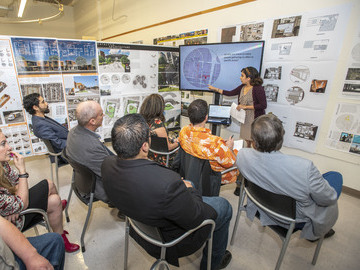A design-centered education
In an integrated, design-centered environment that extends into the city and beyond, our students explore the territory between the local and the global, context and theory, history and innovation, and the search for universal rules and the immediacy of place-based practice.
Recent innovations and ideas propel both student and faculty explorations, practices and studies: the evolution of technology, digital environments and fabrication, landscape urbanism, sustainability, the tensions inherent in the expanding city and its urban fabric, and the dynamic between product and process. The MArch program is accredited by the National Architectural Accrediting Board (NAAB).

Programs and Resources
Discover what it's like to be an architecture student by exploring our degree programs, curriculum maps, certificate programs, and student work. Explore our studio experiences, signature projects, student portfolios, and achievements. Learn about our accreditation and see the possibilities of our state-of-the-art Makerspace.
Degree Programs
View Programs and DegreesCertificate Programs
View Certificate ProgramsCurriculum Maps
View the Architecture Curriculum MapsStudent Handbook
View the Master of Architecture HandbookSignature Experience
Explore the Signature ExperienceStudent Portfolios
View Student PortfoliosStudent Achievements
View Student AchievementsMakerspace
Experience the Downtown MakerspaceAccreditation
Organizational Memberships and NAAB AccreditationScholarship Hub
Find Scholarship OpportunitiesArchitecture Programs

Your future starts here
Offering degrees and certificates in engineering, architecture, construction science and management, historic preservation, interior design, and urban and regional planning at undergraduate, graduate, and doctoral levels
Applications
For additional information about the programs listed above, including application requirements, or to submit an application, please visit the Admissions website.
When we evaluate your application, we attempt to identify future students who:
- Have demonstrated the ability to succeed in their prior academic programs.
- Will excel in the academic program to which they seek admission.
- Possess qualities that will contribute to a community dedicated to design and creativity, research and scholarship, and teaching and learning.
- Have the capabilities needed to complete the program requirements in a timely manner.
- Show promise to make significant contributions in their future discipline or profession. Each part of the application is an opportunity to demonstrate your qualification.
The Letter of Intent (or Statement of Purpose) is an opportunity to explain what you find important about your chosen field, to discuss what you hope to learn in the program, and to foresee the contribution that you will make with the knowledge and skills obtained in the graduate program.
For applicants to the Master of Science in Architecture program, the Letter of Intent should describe the proposed topic of research for the applicant, why it is important, and why s/he wants to pursue it. The Master of Science in Architecture program has two different options: Thesis option and Research/Practice (Non-thesis) option. For applicants who apply to M.S.Arch Research/Practice option, the option selection MUST be clearly indicated in the letter of intent.
Requesting Letters of Recommendation is an opportunity to highlight your achievements under the direction or tutelage of professors, mentors, professional supervisors, etc. At least one of the letters should come from a professor who taught you during your undergraduate course of study (and requesting both letters from former professors is perfectly acceptable).
We look for an undergraduate GPA of 3.0 or higher. Applications with a minimum GPA of no less than 3.0 in the applicant’s last 60 semester credit hours of coursework (including all graduate and postgraduate coursework taken) will be reviewed for admission. Only in exceptional cases will we consider the applications of those with GPAs lower than 3.0.
The requirement for GRE exam scores has been suspended for applications to spring, summer, fall 2022.
A portfolio is required and an extremely important part of all M.Arch2 and M.Arch3 applications. It should include evidence of recent creative work: personal, academic or professional. It is a means whereby the candidates can communicate the full range of their past experiences and future direction. Choose what you care about, what demonstrates your best achievements, and what is expressive of you.
We expect that the portfolio will be created solely by the applicant. The members of the admission committee are interested in the quality of the work submitted. We suggest that you select a limited number of examples that demonstrate your qualifications and capabilities in the strongest way possible. We assume that the images represent the actual quality of the original work with regards to line character, color, value, finish and other visual characteristics. The portfolio -- like all other parts of the application -- must be submitted digitally, via the application portal. While there is no strict requirement with regards to the format or the program that you use to create the portfolio, we recommend highly that you save it as a pdf file, and submit the pdf. Web-based portfolios will only be evaluated if their content is saved as a pdf file and submitted via the application portal.
For applicants to the Master of Architecture 2 program, the portfolio is an opportunity to demonstrate the quality of your analytical investigations or your architectural designs, including your graphic and model-making skills, your ability to integrate the technical requirements of a building in to a design, and your capability to produce presentations that successfully communicate an integrated design. If you have worked on a group project, or in a professional office, you might include work accomplished in those settings (but please indicate clearly what your personal contribution was to the material included). Written descriptive text should accompany the images, but ought to be kept to a minimum.
For applicants to the Master of Architecture 3 program, we understand that you do not have previous education and training in architecture. However, the portfolio is an opportunity for you to demonstrate your creativity and skills, knowledge, aptitude and experience. In the past, successful applicants have included images of their drawings, paintings and sculptures, interior designs, graphic designs, furniture (including initial sketches, in-process photos, and photos of the final product), ceramics, jewelry, and photography. If what you include is the product of a group effort, please indicate clearly what your personal contribution was. Written descriptive text should accompany the images, but ought to be kept to a minimum.
The Writing Sample is an opportunity to demonstrate your ability to write an academic paper. As the Master of Science program is aimed at preparing students for careers in academic research, post-professional research, teaching, and consulting, the program stresses critical writing and research methods.
Your application, therefore, needs to reflect your abilities to successfully complete the degree. The writing sample may take the form of reports, essays, book reports, and research papers which you may have completed in previous coursework, on the job, or independently. You may prefer to select (or prepare) writing samples which apply and/or inform the subject you wish to study through the Master of Science program. All samples should display a command of accepted rules for written English grammar and punctuation. At least one of them should demonstrate the applicant's ability to: 1) propose a thesis and create a well-structured argument in support of that thesis, 2) select appropriate sources and use information to create that argument, and 3) cite sources appropriately, following academic standards for citations; APA (American Psychological Association) or CMS (Chicago Manual Style) format.
Please limit your submission to no more than 3 writing samples and provide an introductory context for each (i.e., "This paper was written to...." or "This paper was written in response to...."). In some exceptional cases, the writing sample may communicate new knowledge from an applicant's research.
9
Undergraduate Majors
15
Master's Degrees
6
Doctoral Degrees
8
Certificate Programs




